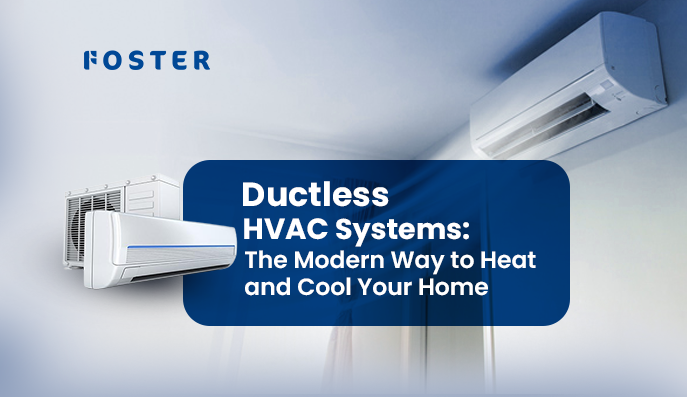As energy costs continue to rise and homeowners seek more flexible climate control solutions, ductless HVAC systems have emerged as a game-changing alternative to traditional heating and cooling methods. Whether you’re renovating an older home, adding a new room, or simply looking to improve your comfort while reducing energy bills, understanding ductless technology can help you make an informed decision. At Foster International, we’ve helped countless property owners discover the advantages of ductless systems. This comprehensive guide will walk you through everything you need to know about ductless HVAC systems, from how they work to maintenance best practices.
What is a Ductless HVAC System?
A ductless HVAC system, also known as a mini-split system or ductless mini-split air conditioner, is a heating and cooling solution that doesn’t require traditional ductwork to distribute conditioned air throughout your space.Learn more about HVAC systems to understand how ductless compares to other options. The system consists of two main components: an outdoor compressor/condenser unit and one or more indoor air-handling units. These components are connected by a small conduit that houses the power cable, refrigerant tubing, suction tubing, and condensate drain.
Unlike conventional central HVAC systems that force air through a network of ducts, ductless systems deliver conditioned air directly into individual rooms or zones. This direct delivery method eliminates the energy losses associated with ductwork, which can account for up to 30% of energy consumption in traditional systems—a critical consideration for UAE property owners facing high cooling costs. If you’re interested in exploring energy-efficient cooling solutions, Foster International offers comprehensive consultations to help you choose the right system.
Types of Ductless Systems:
Single-Zone Mini-Splits:
- One outdoor unit connected to one indoor unit
- Ideal for single rooms, home offices, or small apartments
- Perfect for targeted cooling in specific areas
- Cost-effective solution for smaller spaces
Multi-Zone Systems:
- One outdoor unit connected to multiple indoor units (up to 8 zones)
- Excellent for whole-home or commercial cooling
- Independent temperature control for each zone
- Scalable solution that grows with your needs
Since their introduction to the Middle East market, ductless systems have evolved significantly, now offering advanced features like smart home integration, Wi-Fi connectivity, improved energy efficiency ratings (SEER 20-30+), and whisper-quiet operation—essential for maintaining comfort in UAE’s demanding climate conditions.
How Do Ductless HVAC Systems Work?
A ductless HVAC system, also called a mini-split, provides heating and cooling without ducts. It has two main components: an indoor air-handling unit and an outdoor compressor/condenser connected by refrigerant lines.
- Cooling: The indoor unit absorbs heat from the room, transfers it via refrigerant to the outdoor unit, which releases the heat outside.
- Heating: In heat pump systems, the cycle reverses—heat from outside is drawn in and circulated indoors.
- Zoning & Control: Each indoor unit can be controlled individually, allowing different temperatures for different rooms.
- Smart Features: Many systems include timers, remote or smartphone controls, and energy-saving modes.
This direct heat exchange and zone control make ductless systems energy-efficient, flexible, and ideal for spaces without ductwork.
Ductless vs Traditional/Central HVAC Systems: Which is Right for You?
| Feature | Ductless HVAC | Traditional HVAC |
| Installation | Small wall hole; quick and non-disruptive | Extensive ductwork; invasive and time-consuming |
| Energy Efficiency | Direct air to rooms; minimal energy loss | 25–40% energy loss through ducts |
| Cost | Higher upfront per unit, lower installation, long-term savings | Lower unit cost, high duct installation, more energy loss |
| Flexibility | Easy to add zones; ideal for renovations | Expansion requires major changes |
| Aesthetics | Sleek wall/ceiling units | Bulky vents and registers throughout |
Top Benefits of Choosing a Ductless HVAC System
Ductless HVAC systems offer numerous advantages, making them a popular choice for homes and businesses.
- Zoning & Personalized Comfort: Each indoor unit operates independently, allowing different rooms to maintain their own temperature. Say goodbye to thermostat wars and enjoy customized comfort.
- Improved Indoor Air Quality: Without ducts to harbor dust, allergens, and mold, ductless systems use multi-stage filters to reduce pollen, bacteria, and other particles, keeping your air cleaner and healthier.
- Quiet Operation: Indoor units run at 19–32 decibels—quieter than a whisper—perfect for bedrooms, offices, or study areas.
- Quick & Easy Installation: Systems can be up and running in as little as one day, avoiding the lengthy process of installing ductwork.
- Energy Efficiency & Savings: High SEER ratings (20–30+) combined with zone control can reduce heating and cooling costs by 30–50%, lowering utility bills.
- Eco-Friendly Refrigerants: Modern systems use environmentally safe refrigerants like R-410A, reducing your carbon footprint.
- Increase Property Value: Sleek design, energy efficiency, and year-round comfort make your home more attractive to buyers.
Ductless HVAC systems provide efficient, flexible, quiet, and eco-friendly comfort, making them a smart long-term investment.
Is a Ductless System Right for Your Space? Key Indicators
A ductless HVAC system may be the perfect solution in several situations:
- Home Additions & Renovations: Ideal for sunrooms, garages, basements, or extensions where adding ducts is impractical.
- Older Homes: Homes without existing ductwork can enjoy modern comfort without compromising architectural features.
- Hot & Cold Spots: Zone control allows consistent temperatures in every room, solving uneven heating or cooling.
- Rising Energy Bills: Inefficient traditional systems can be replaced with energy-saving ductless units.
- Customized Climate Control: Perfect for offices, bedrooms, or spaces needing different temperatures simultaneously.
- Limited Space: Compact indoor and outdoor units fit where traditional HVAC equipment won’t.
- Improved Air Quality: Superior filtration reduces dust, allergens, and pollutants.
- Historic Buildings: Minimal installation disruption preserves architectural integrity.
- Multi-Unit Buildings & Apartments: Provides individual climate control without complex shared ductwork.
In short: If you face any of these scenarios, a ductless HVAC system can offer efficient, flexible, and comfortable heating and cooling for your space.
Essential Maintenance Tips to Maximize Your Ductless HVAC System’s Lifespan
per maintenance ensures your ductless HVAC system runs efficiently and can last 15–20 years or more.
Monthly Tasks:
- Clean or replace indoor unit filters. Most are washable—rinse, dry, and reinstall.
- Maintain airflow and indoor air quality.
Quarterly Tasks:
- Inspect the outdoor unit; remove leaves, debris, and ensure 2 feet of clearance.
- Check that the unit is level and drains properly.
Annual Professional Maintenance:
- Check refrigerant levels, clean coils, inspect electrical connections, lubricate moving parts, and verify airflow.
- Schedule pre-season tune-ups in spring and fall to prevent peak-season issues.
Additional Tips:
- Keep indoor units unobstructed by furniture or curtains.
- Monitor for unusual noises or odors.
- Clean indoor unit exteriors and vents.
- Check remote batteries and thermostat settings.
Warning Signs Requiring Professional Attention:
- Water leaking from indoor units
- Ice formation on coils
- System runs constantly without reaching set temperature
- Unusual energy consumption or error codes
Common Ductless HVAC System Problems and Solutions
| Problem | Possible Cause | Solution |
| Reduced heating/cooling | Dirty filters, blocked outdoor unit, refrigerant issues | Clean filters, clear debris; call professional if persists |
| Water leakage | Clogged condensate line | Clear minor clogs; call professional for recurring issues |
| Strange noises | Loose components, fan/motor issues | Inspect for loose parts; professional check if persistent |
| Unpleasant odors | Mold/mildew, electrical issues | Clean unit; call professional for electrical issues |
| Remote issues | Dead batteries, mispaired remote | Replace batteries, ensure proper pairing |
| Frozen coils | Restricted airflow, low refrigerant | Turn off system; contact professional |
DIY vs Professional:
Knowing when to attempt DIY fixes versus calling professionals is important. You can safely clean filters, clear minor debris from outdoor units, replace remote batteries, and reset the system according to manufacturer instructions. However, refrigerant issues, electrical problems, component replacements, persistent drainage issues, and any problem involving disassembling the unit require professional service to maintain warranty coverage and ensure safety.
Ductless HVAC Installation: What to Expect
- Proper Sizing:
- Load calculations consider space, insulation, windows, sun exposure, and usage. Correct sizing ensures efficiency and comfort.
- Unit Placement:
- Indoor units: mounted high, away from direct sunlight, unobstructed airflow.
- Outdoor units: level, with proper clearance, protection from weather, and easy maintenance access.
- Installation Timeline:
- Single-zone: 4–8 hours
- Multi-zone: 1–2 days
- Minimal disruption; a small wall hole connects indoor and outdoor units.
- Professional Installation Benefits:
- Certified installers follow manufacturer guidelines and local codes.
- Ensures optimal performance, efficiency, and warranty coverage.
- Includes system walkthrough, controls demonstration, and maintenance guidance.
- Warranty Considerations:
- Proper installation and registration are required to maintain manufacturer warranties.
- Keep all installation and service records for extended warranty eligibility.
For seamless installation, refer to our product lineup to choose the system that best fits your space.
Conclusion
Ductless HVAC systems represent a smart, efficient solution for modern heating and cooling needs. With superior energy efficiency, flexible zone control, improved indoor air quality, and quiet operation, these systems deliver exceptional comfort while reducing your environmental footprint and utility costs. Whether you’re dealing with a home without existing ductwork, planning an addition, seeking better climate control, or simply ready to upgrade to more efficient technology, ductless systems offer compelling advantages over traditional HVAC options.
The combination of lower operating costs, minimal installation disruption, and long-term reliability makes ductless systems a valuable investment in your property and comfort. As energy costs continue rising and environmental concerns grow more pressing, choosing an efficient, modern HVAC solution becomes increasingly important.
At Foster International, we’re committed to helping you find the perfect climate control solution for your space. Our experienced technicians can assess your needs, recommend the right system size and configuration, and provide professional installation backed by our commitment to quality and customer satisfaction. Don’t let another season pass with inefficient heating and cooling—contact Foster International today for a free consultation and discover how a ductless HVAC system can transform your comfort and energy efficiency. Your ideal indoor climate is just a phone call away.



 Previous Post
Previous Post
